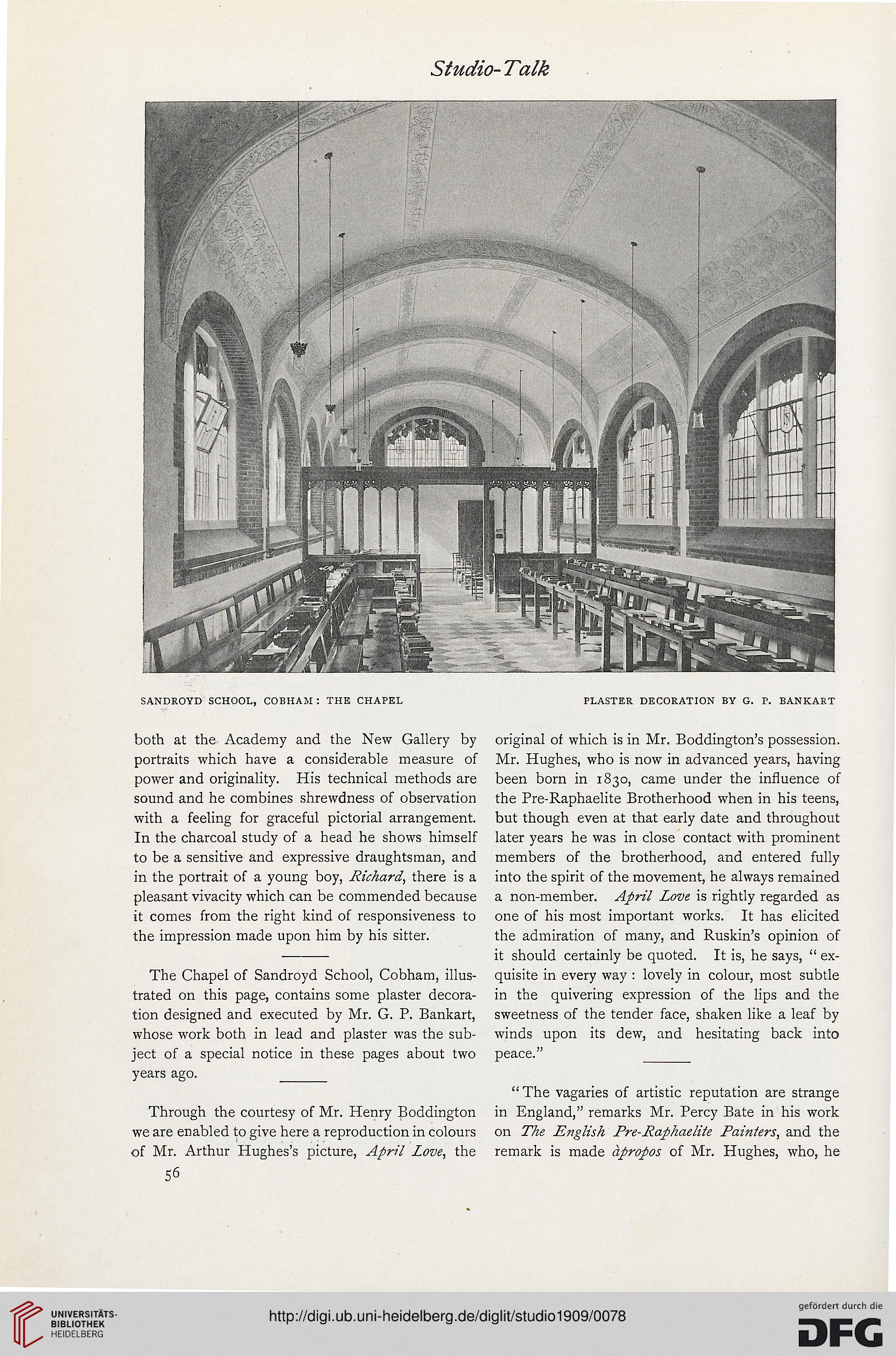Studio- Talk
GätiHSBS
^ 1
■l b A
1 A
pugl
IK r.
A
çM mr-
H
I -
|p
1 n
HI
— ft
SANDROYD SCHOOL, COBHAM : THE CHAPEL
PLASTER DECORATION BY G. P. BANKART
both at the Academy and the New Gallery by
portraits which have a considerable measure of
power and originality. His technical methods are
sound and he combines shrewdness of observation
with a feeling for graceful pictorial arrangement.
In the charcoal study of a head he shows himself
to be a sensitive and expressive draughtsman, and
in the portrait of a young boy, Richard., there is a
pleasant vivacity which can be commended because
it comes from the right kind of responsiveness to
the impression made upon him by his sitter.
The Chapel of Sandroyd School, Cobham, illus-
trated on this page, contains some plaster decora-
tion designed and executed by Mr. G. P. Bankart,
whose work both in lead and plaster was the sub-
ject of a special notice in these pages about two
years ago.
Through the courtesy of Mr. Henry Boddington
we are enabled to give here a reproduction in colours
of Mr. Arthur Hughes’s picture, April Love, the
56
original of which is in Mr. Boddington’s possession.
Mr. Hughes, who is now in advanced years, having
been born in 1830, came under the influence of
the Pre-Raphaelite Brotherhood when in his teens,
but though even at that early date and throughout
later years he was in close contact with prominent
members of the brotherhood, and entered fully
into the spirit of the movement, he always remained
a non-member. April Love is rightly regarded as
one of his most important works. It has elicited
the admiration of many, and Ruskin’s opinion of
it should certainly be quoted. It is, he says, “ ex-
quisite in every way : lovely in colour, most subtle
in the quivering expression of the lips and the
sweetness of the tender face, shaken like a leaf by
winds upon its dew, and hesitating back into
peace.” _
“The vagaries of artistic reputation are strange
in England,” remarks Mr. Percy Bate in his work
on The English Pre-Raphaelite Painters, and the
remark is made àpropos of Mr. Hughes, who, he
GätiHSBS
^ 1
■l b A
1 A
pugl
IK r.
A
çM mr-
H
I -
|p
1 n
HI
— ft
SANDROYD SCHOOL, COBHAM : THE CHAPEL
PLASTER DECORATION BY G. P. BANKART
both at the Academy and the New Gallery by
portraits which have a considerable measure of
power and originality. His technical methods are
sound and he combines shrewdness of observation
with a feeling for graceful pictorial arrangement.
In the charcoal study of a head he shows himself
to be a sensitive and expressive draughtsman, and
in the portrait of a young boy, Richard., there is a
pleasant vivacity which can be commended because
it comes from the right kind of responsiveness to
the impression made upon him by his sitter.
The Chapel of Sandroyd School, Cobham, illus-
trated on this page, contains some plaster decora-
tion designed and executed by Mr. G. P. Bankart,
whose work both in lead and plaster was the sub-
ject of a special notice in these pages about two
years ago.
Through the courtesy of Mr. Henry Boddington
we are enabled to give here a reproduction in colours
of Mr. Arthur Hughes’s picture, April Love, the
56
original of which is in Mr. Boddington’s possession.
Mr. Hughes, who is now in advanced years, having
been born in 1830, came under the influence of
the Pre-Raphaelite Brotherhood when in his teens,
but though even at that early date and throughout
later years he was in close contact with prominent
members of the brotherhood, and entered fully
into the spirit of the movement, he always remained
a non-member. April Love is rightly regarded as
one of his most important works. It has elicited
the admiration of many, and Ruskin’s opinion of
it should certainly be quoted. It is, he says, “ ex-
quisite in every way : lovely in colour, most subtle
in the quivering expression of the lips and the
sweetness of the tender face, shaken like a leaf by
winds upon its dew, and hesitating back into
peace.” _
“The vagaries of artistic reputation are strange
in England,” remarks Mr. Percy Bate in his work
on The English Pre-Raphaelite Painters, and the
remark is made àpropos of Mr. Hughes, who, he




